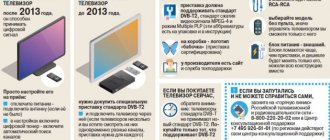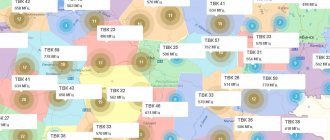Should you worry and what should you do if the TV in your home is still a “window to the world?”
Russia will soon make the transition to the digital format of television broadcasting. From January 1, 2021, the analog signal of federal channels began to disappear in the regions. From June 3, the remaining regions, including the Sverdlovsk region, will switch to digital. City television companies are in an unenviable position - they are predicted to die out. Znak.com tells you whether you should worry and what to do if the TV in your home is still a “window to the world.”
What is the transition to digital?
We are talking about the next stage in the transition to a more modern - digital - broadcasting format, which began in Russia nine years ago. At the end of last year, the federal target program “Development of television broadcasting in the Russian Federation for 2009–2018” ended. It assumed federal budget expenditures to compensate for the costs of television channels for transmitting terrestrial broadcast signals in analog format. This year’s budget no longer provides for such expenses, so immediately after the New Year holidays, the country began to turn off equipment transmitting an analog signal. By the way, there is already a region in Russia that has completely switched to digital. The first region was the Tver region, where on November 9, 2021, in the presence of officials of the Ministry of Telecom and Mass Communications, a symbolic start was given to farewell to analogue broadcasting throughout the country. Within six months of 2021, the remaining regions will switch to digital, the deadline is June 3. The Sverdlovsk region also fell into it.
Instead of “digits” - satellite
It was planned that the transition to digital broadcasting in Russia would take place in three stages, but in mid-May the Ministry of Digital Development, Communications and Mass Communications of Russia changed the transition schedule, adding a fourth. Now the last analogue shutdown in 21 regions is scheduled for October 14. This decision was explained by the need to give more time for the preparation of documents for compensation when purchasing digital equipment for the poor and other problems.
In the Sverdlovsk region, during this week, a 12-minute video with information about the transition to digital television will be broadcast on frequencies where there were previously analogue TV channels. However, the video will not be available in the settlements of Andryushino and Nikhvor, Garinsky district. Local residents are notified of all details of the transition to digital in other ways, the Department of Information and Communications of the Sverdlovsk Region told Oblgazeta.
At the same time, there are territories located outside the zone of on-air digital broadcasting: in total there are 18,000 such settlements in Russia, and 410 in the Sverdlovsk region. Residents of such territories will be able to watch 20 free digital channels only through a satellite dish (Oblgazeta wrote about this in No. 025 dated February 12, 2019).
“You need to contact the person whom this locality has appointed responsible for collecting collective applications for connecting satellite television, or independently order the necessary equipment from the satellite operator,” explained the head of the department for the development of the information and telecommunications industry and communications of the Department of Information and Communications of the Sverdlovsk Region to Oblgazeta. Denis Maltsev .
In the Middle Urals, the poor are provided with compensation in the amount of 90 percent of the cost of equipment for receiving a digital signal (Oblgazeta wrote in detail about how to receive compensation in No. 221 of November 30, 2018). However, satellite television broadcasting is still more expensive than digital: the average cost of a set for “digital” is 2,700 rubles, and for satellite – 6,000 rubles. People need to choose: either watch only 20 free channels on the satellite, or receive them in addition to those available on the satellite dish, but for a subscription fee. Some residents of the region still remain in the dark about how exactly they will be able to receive a television signal after June 3, which is what they call Oblgazeta about.
“I bought a set-top box for digital television, and recently read in the local press that digital broadcasting in our municipality will only be in the regional center and nine settlements near it,” addressed our reader from the village of Volokushino, Artinsky district, Valery Cherepanov . – Nobody told us about this before or informed us about the need to connect satellite television. It turns out that digital broadcasting will not be available throughout the country? We, in the villages, are left without “digits”.
What is all this for?
Well, first of all, analog television is literally a thing of the past. The whole world is moving to a new digital signal distribution standard, which, firstly, has better image and sound quality, and secondly, is more economical: if one frequency of an analog signal transmits only one program, then in “digital” - up to 10. And Russia, of course, has no business trailing behind. On the one hand, the country at one time took upon itself the corresponding international obligations, and on the other, all this is especially relevant now, when a course for a rapid breakthrough into a new, digital era has been proclaimed from high rostrums.
However, irony aside, let’s look at the data that the Ministry of Telecom and Mass Communications operates. Some nine years ago, about a quarter of Russians had the opportunity to watch only two, or even just one, TV channels. More than 40% of viewers were content with only four “buttons.” And this, of course, is not the 21st century.
Now the territory where more than 98% of TV signal consumers in Russia live is covered by digital broadcasting, which makes it possible to watch 20 programs.
Moreover, in incomparably better quality and, importantly, still completely free. By the way, if you believe official sources, reducing the volume of analogue television will free up new frequency capacity for the emergence of the third and subsequent multiplexes - in other words, making the TV menu of Russians even more voluminous and varied.
Who will pay for this?
The digital television broadcasting infrastructure was deployed at the expense of the state, which has its own motives for this. The point, of course, is not only the idea that television is a powerful tool for influencing moods in society. One way or another, the state fulfilled its task. The question now is the ability of each individual household to receive 20 digital channels.
This is more difficult. According to the Ministry of Industry and Trade, at the end of 2021, more than 33.5 million televisions in Russian homes (this is approximately 30% of the total “park” of home television equipment in the country) can only receive an analog signal. Their owners, even if they are cable television subscribers, will have to either change their television receivers or buy special set-top boxes when analogue broadcasting is switched off. The second way is less expensive, although perhaps someone will take the opportunity to purchase a new TV with a built-in digital tuner.
If you still decide to make do with old technology for now, the costs of switching to “digital” will depend on how the signal is received. Cable TV subscribers will only spend money on a set-top box. Its cost starts from 700-800 rubles, but it is possible that the cable network operator will time some promotion to coincide with the transition to digital or offer to rent equipment for symbolic money. We must keep in mind that a separate set-top box will be required for each “old” TV that is in the apartment.
You will still have to pay for using cable channels after switching to digital.
Most modern TVs already have a built-in digital signal receiver, so there is no need to buy a separate set-top box
The situation is similar with a collective antenna. It is only important that the antenna itself, installed, say, on the roof of an apartment building, can receive a digital signal. The good news is that the new standard for the construction of multi-apartment housing in many regions involves equipping them with collective television reception systems. Having moved into an apartment equipped with such a system, the subscriber will only need to connect his new television receivers to it.
For those who are for individualism, a set of a set-top box and an apartment digital antenna will cost about 1.5 thousand rubles. You will have to spend a little more on an individual antenna, which will need to be installed on the roof of a private house or cottage. The advantage is that all this is a one-time expense; no one will have to pay for anything further. If you are not particularly picky when choosing a TV menu, this is quite your option.
What is important to know about the console?
There are already approximately 400 (!) models of set-top boxes on the market, the cost of which depends on the set of functions, as well as the reliability and durability declared by the manufacturers. First of all, as, by the way, when buying a new TV, you need to pay attention to the presence of the DVB-T2 logo. Then the device will accurately receive the digital terrestrial television signal.
It’s even better if there is a logo in the shape of a butterfly, under which the digital broadcasting of RTRS is promoted - the Federal State Unitary Enterprise “Russian Television and Radio Broadcasting Network”, which, in fact, builds the digital broadcasting infrastructure in our country. This means the device is certified by RTRS. That is, an additional guarantee is given that everything will work as it should.
Otherwise, everything is the same as with other home appliances: pay attention to the warranty period, availability of service, reviews. By the way, also take a look at the RTRS website (look at digital.rf) - we have a lot of useful information on how to connect digital TV, eliminate interference, etc.
RTRS digital television will jeopardize the Sverdlovsk region's 1.2 billion ruble project
The federal project for the introduction of digital television in the Sverdlovsk region is in full swing. At the end of the second quarter, the first and second stages of its implementation are planned to be completed in the region: 19 facilities will be built to accommodate antenna equipment for digital television broadcasting.
“At the third and subsequent stages, it is planned to build 46 objects (28 of them in 2013) with new supports with a height of 50 to 150 m, on specially designed and leased branches of the Regional Radio and Television Transmission Center of the federal unitary state enterprise Russian Television and Radio Broadcasting Network “land plots,” the Ministry of Transport and Communications of the Sverdlovsk Region told Pravda URFO.
The RTRS digital broadcasting project is planned to be fully completed in 2015. At the same time, digital broadcasting in the region is already carried out by Digital Television OJSC. Ministry officials cannot say how the networks of FSUE RTRS and the Ural company, whose services are used by about 300 thousand residents of the region, will connect. , Eduard Rossel’s ambitious project to create digital television cost at least 1.2 billion rubles. About 1 billion of this amount comes from the personal funds of citizens spent on the purchase of digital signal receivers, more than 200 million rubles - on laying networks. However, according to one of the initiators of the creation of a qualitatively new TV, the former owner of Digital Television Alexander Mikha , several billion were invested in the project. However, no reports were provided on how these funds were spent. Now regional digital TV requires new investments.
“80% of the region’s population has the opportunity to receive our signal, approximately 20–25% receive it. A total of 104 thousand subscribers are connected. Now a lot depends on FSUE RTRS. The fact is that when the federal target project was adopted in the region (2011 - Ed.), digital broadcasting standards were changed. Our networks were built according to the old DVB-T standard, now broadcasting (within the framework of a target project - Editor's note) is offered via DVB-T2. Receivers for DVB-T are not suitable for networks of the new standard. DVB-T2 receivers are suitable for both,” explains technical director of Digital Television OJSC Alexander Serov.
FSUE RTRS will create its digital broadcasting system no later than 2015. The emergence of a competitor with incomparable capabilities on the market will force the regional broadcaster to quickly switch to the DVB-T2 standard. The Ural company is already preparing for this and is selling receivers aimed at new generation networks. However, with the arrival of the Federal State Unitary Enterprise, the Ural television broadcaster may not be able to withstand the competition. For now, its advantage over the federal player is the ability to transmit regional TV channels in digital format. In the Sverdlovsk region these include Channel 4, and in Yekaterinburg also Channel 41. In Gary, Kushva, Nevyansk, Novoutkinsk and other satellite cities, the Khanty TV channel “Yugra” broadcasts on Digital Television networks. The issue of providing broadcasting in digital format on the networks of FSUE RTRS to regional channels is still open.
“Now is the busiest time. The future of our company, regional and municipal channels depends on the decision at the Ministry of Communications,” Alexander Serov does not hide.
RTRS has not yet completed the formation of a pool of TV channels. Mandatory for broadcasting, the so-called channels of the first multiplex are “Russia 1”, “Russia 24”, NTV, “Russia 2”, “Culture”, “Carousel”, TRK-5, “Sport”, and 3 radio channels - “Radio Russia ", "Mayak", "Vesti FM". As Pravda URFO wrote earlier, the formation of a pool of additional TV channels – channels of the second multiplex – has been completed. In December 2012, RTSR announced the names of the participants: REN TV (National Media Group), TVTs, STS Media TV channels - STS and Domashny, Sport 1 (owned by the Federal State Unitary Enterprise VGTRK), Sport+ (part of package of channels "NTV+"), "Zvezda", MIR, TNT (Gazprom Media) and MUZ TV (YUTV holding). By 2015, television companies will have to pay 944 million rubles annually for guaranteed work in the second multiplex.
“Now there is a question about a third multiplex and the inclusion of regional TV channels there, such as OTV, Channel 4.” They are included in our networks. The decision on a third multiplex will also have an impact on small local TV channels. Let's say there is analog TV in Irbit with its own transmitter. How will such a channel work in a multiplex: either they will be provided with insertions on regional channels, or they will be given the opportunity to convert their signal to digital. They can go to work in cable television or on the Internet,” Alexander Serov describes the situation.
In the Sverdlovsk region, the issue of choosing networks with the advent of the global digital broadcasting project will face 15 city TV channels.
“The question of which multiplexes will be used for regional channels is still open. Everything is technically possible. The problem of ousting regional television companies should not arise. Everything depends on legislative regulation. Until now, no rules have been adopted that clearly differentiate the responsibilities of TV channels and operators. Much for TV channels will depend on the cost of digital broadcasting. This is quite an expensive pleasure,” Igor Lebedev, technical director of Channel 4, shared his opinion with Pravda URFO.
With an increase in broadcasting costs, it is logical to assume that the TV company’s costs will be covered by rising prices for advertising services, and this will inevitably affect the prices of an entire group of goods, advertising market experts say.
For reference : DVB-T2 (Digital Video Broadcasting – Second Generation Terrestrial) is the second generation of the DVB-T standard, the European standard for terrestrial digital television. The improved DVB-T2 standard is designed to increase the capacity of digital terrestrial (terrestrial) television networks by at least 30% compared to DVB-T with the same network infrastructure and frequency resources.
Multiplex is a package of television and radio channels broadcast by one digital transmitter. The entire multiplex can occupy either one or several radio frequencies. The DVB-T standard supports 8–9 channels, DVB-T2 up to 12 channels. Also, additional signals, such as teletext, can be included in the multiplex.
In 2011, the general director and co-owner of Digital Television OJSC, Alexander Mikh, announced the sale of a stake to the Ministry of State Property Management of the Sverdlovsk Region. According to him, MUGISO gained control over 100% of the OJSC. However, according to the Spark information system, as of February 2012, MUGISO owns 25.68% of Digital Television.
If switching to digital is not affordable, will I be left without television?
Probably yes. Federal channels are completely switching to digital broadcasting. You may still be able to receive a local TV program or two from regional broadcasters who will continue to distribute analog signals.
Another thing is that maintaining and maintaining infrastructure for broadcasting in analog format is not a cheap pleasure. In addition, for now the lion's share of the costs of paying for these services is borne by federal broadcasters. So most likely they will stop analogue broadcasting.
What is the point of caring for a viewer who is not able to pay for cable television services or even a one-time purchase of a digital TV set? Moreover, the state also expresses its determination not to leave a single home without television “digital”. Dmitry Medvedev gave the corresponding instructions. Regional budgets for this year provide money to compensate for the costs of socially vulnerable categories of citizens for the purchase of set-top boxes. Regional and local authorities, through the media and social protection authorities, began to explain to whom these compensations are due and under what conditions. True, the help is not widespread.
However, approximately 1.5% of Russians will remain outside the coverage of digital broadcasting. Once analog TV is switched off, they will only have one option - satellite TV. We are talking about approximately 800 thousand households, and this is the population of two, or even three million-plus cities. The advantage is that most of these subscribers have long ago acquired satellite dishes themselves. But for those who suddenly have difficulties with this, the state also promises to help by launching appropriate social programs.
21st and 22nd buttons
Another problematic issue that has been discussed for a long time with the transition to digital broadcasting is what will happen to local TV channels. Some began to actively go online and into cable broadcasting, but now regional and municipal channels have a chance to break into digital. In each subject of the country, they chose a public channel, which will be assigned the 21st position on the television console, and recently information appeared that regional channels will be allowed to broadcast on Public Television of Russia (OTR) approximately from November 2021. At the same time, the Russian Television and Radio Broadcasting Station (RTRS) notes that not all TV channels will stop broadcasting in analogue format: each regional or local television company itself makes the decision to continue broadcasting in analogue.
– With OTR, the situation is very dynamic: the channel offers for discussion the possibility of “tapping in” for regional companies from 6:00 to 9:00 in the morning and from 17:00 to 19:00 in the evening, before prime time. The time is inconvenient. First of all, we are fighting for the possibility of our own digital broadcasting; I and many of my colleagues consider this the most correct thing,” Anton Stulikov, . – Sverdlovsk OTV will claim the right to tie into OTR. We are not just monitoring the situation, but influencing it through the National Association of Television and Radio Broadcasters and the Union of Journalists of Russia. It has already been achieved that connections to OTR will not require funding from the regional budgets. The dialogue continues, with the participation of heads of dozens of regional television companies from all over the country.
For municipal channels, a 22nd digital button is provided: the law on it was adopted in the third reading by the State Duma at the end of May. But this will not be a solution to the problem for everyone.
– The 22nd button will work in cable networks during the transition to digital broadcasting. In our city there are not many comfortable houses where cable broadcasting is possible, so this will not really save our channel, but we will still be on the 22nd button if it appears, says Elena Inkova, director of the Channel 6 media holding in Talitsa . — We are now actively working on the Internet and remain on analogue broadcasting, but the best solution for us would be the possibility of obtaining a digital license locally.
BY THE WAY
Let us remind you that 1,200 volunteers are helping residents of the Sverdlovsk region switch from analogue to digital television. All questions related to turning off analogue television broadcasting can be asked to regional hotline operators at 8–800–250-89–60 or to federal hotline operators at 8–800–220-20–02. Also, all relevant information is posted on the official website SMOTRICIFRU.RF (aka rtrs.ru).
- Published in No. 95 of 06/04/2019











